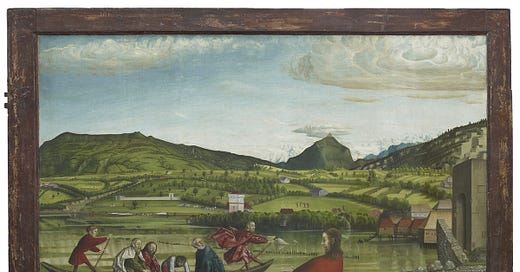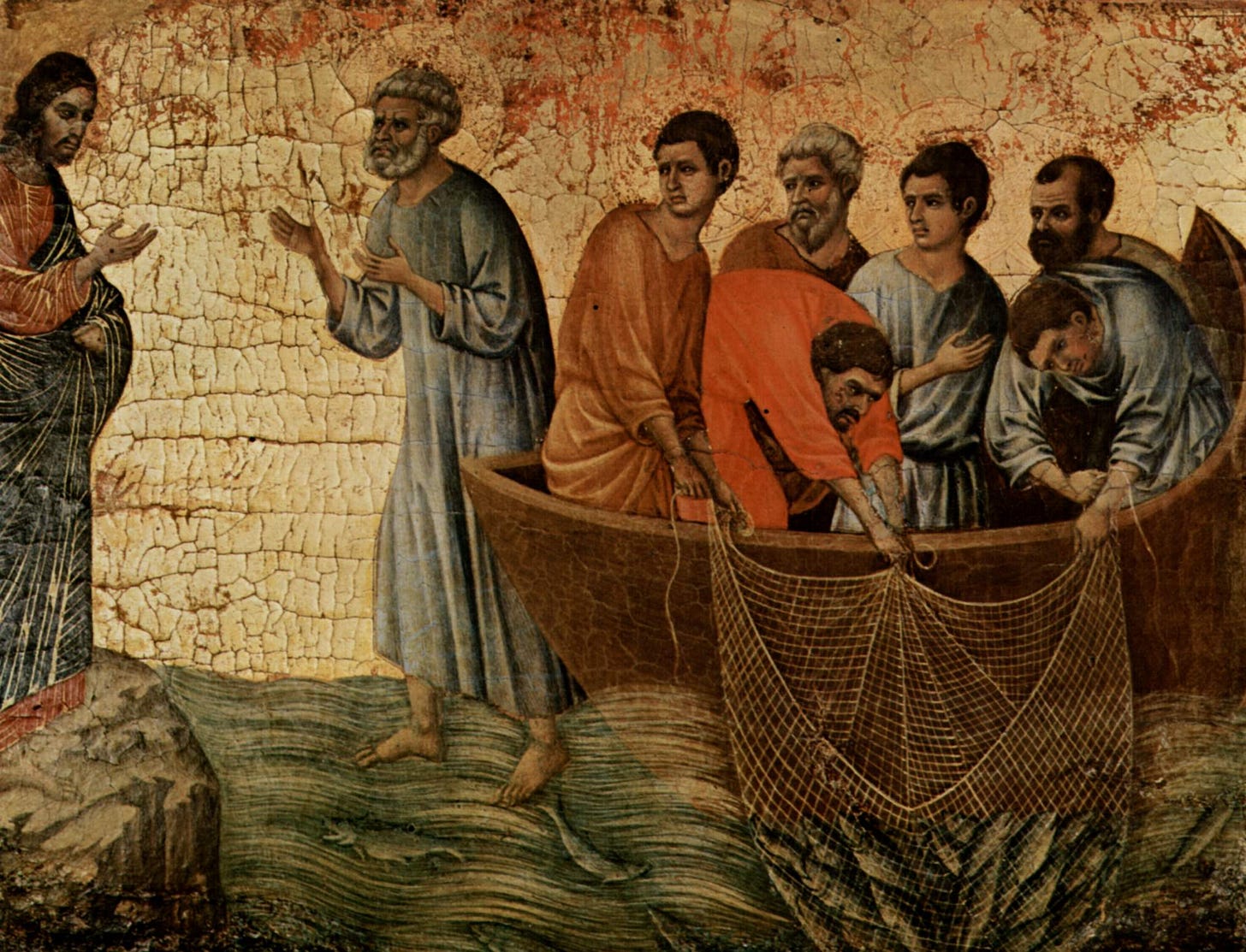La Pêche miraculeuse
The first true landscape portrait in Western art is a masterpiece of subtle political propaganda.
I've always been captivated by the idea of using art history not only as a window into aesthetic tastes across times and places but as a powerful tool to understand the political and economic forces that have shaped historical periods and, in turn, influenced taste and aesthetics. This perspective was passed on to me by Ernst Gombrich, through his extraordinary book, The Story of Art. I read it twice, at different times in my life, and I still consider it remarkable—not for technical details that might appeal more to seasoned art enthusiasts, but for its broad, insightful approach. Gombrich’s ability to make sense of the apparent chaos of art history, drawing clear, almost geometric connections across periods and movements, inspired me profoundly. It’s this approach that introduced me to Konrad Witz, an artist not widely known, not prolific, and whose life remains largely obscure, yet remembered for a single, groundbreaking work now preserved at Geneva’s Museum of Art and History.
Welcome to the Borderliner.
The Painting
Dated 1444, The Miraculous Draught of Fishes was originally part of a series created for the choir of St. Peter's Church in Geneva. Today, along with another related panel, it resides in Geneva’s Art and History Museum. The painting depicts the Gospel story of Christ’s miraculous appearance to the apostles, guiding them to a bounty of fish despite their unsuccessful efforts on the Sea of Tiberias.
Context and Innovation
Viewing Christological paintings from the early Christian period through to the Renaissance, we often sense a growing detachment of figures from earthly reality. Over time, these depictions of the divine become increasingly ethereal, conveying a supernatural, almost metaphysical1 quality—precisely because they were intended to capture what transcends human nature. For centuries, religious art avoided lifelike details that might make the divine feel too mortal, preferring a stylised, otherworldly approach to underscore the separation between human and divine.
Yet in the mid-1400s, a shift was beginning. The desire to free art from rigid, spiritually mandated forms was rising, and artists increasingly sought to place Christian history within relatable, real-world settings. Konrad Witz captured this new vision perfectly. For the first time, he set an evangelical scene not in an abstract “holy” space, but in the real waters of the Leman Lake, within view of the very church where the painting would hang. The Geneva landscape itself becomes a protagonist in this scene—looking southward, viewers would see recognisable landmarks: the slopes of Mont Blanc, the landscape of Savoy, and beyond them, Italy.
One can only imagine how the congregation reacted. This painting placed sacred history within their own physical world. If Geneva’s religious doctrine remained unchanged, certainly its aesthetic sense was evolving. Of course, the arrival of John Calvin a few decades later would alter Geneva’s religious landscape entirely, but that is another story.
Politics and Meaning
The artistic choice to place this sacred scene in Geneva’s landscape is profound, but it’s only part of the story. If the painting’s appeal to humanism allowed citizens to reclaim their spirituality, there’s a more complex layer in the decision to situate this scene in Geneva, at that specific time and place. At the heart of this lies the matter of patronage. Although we don’t have conclusive evidence on who commissioned this work, it was likely the prince-bishop2 of Geneva, François de Metz, or perhaps Amadeus VIII of Savoy, the anti-pope3 at the time. Regardless, the commission came from the circle of the House of Savoy, which had a long history of seeking influence over Geneva’s politics.
Throughout history, art has often served political agendas—sometimes explicitly, as with totalitarian regimes, but often subtly, as a means for rulers to consolidate and legitimise their power by establishing cultural connections with the public. This painting serves as a form of political propaganda. Not only is the miracle set on the Leman Lake, but also positioned on the northern shore, with the prominent Savoy symbol of La Môle4 rising in the background. Savoy’s heraldry is visible in the scene, with knights moving toward the city’s lakeshore.

The intention is clear: the commissioner, possibly Amadeus VIII, places Geneva’s landscape within an evangelical scene in the city’s central cathedral, thereby sanctifying the land under Savoy’s emblem. In fact, the first true landscape portrait in Western art is a masterpiece of subtle political propaganda.
The term metaphysical originates from the Greek words "meta-" (μετά), meaning "beyond" or "after," and "physika" (φυσικά), meaning "nature" or "natural things."
A title used to refer to bishops who, especially in the low medieval period, exercised extensive secular power over a territory as amanation of a ruler and the Pope. To date, the only formally still-existing prince-bishop is that of Urgell, who traditionally holds the office of sovereign of Andorra in diarchy with the French president.
Antipope is the title used to define popes elected but not recognised by the Vatican canon as legitimate to date.






